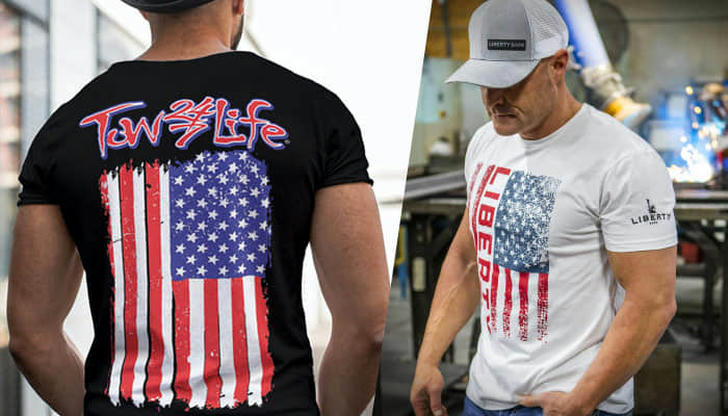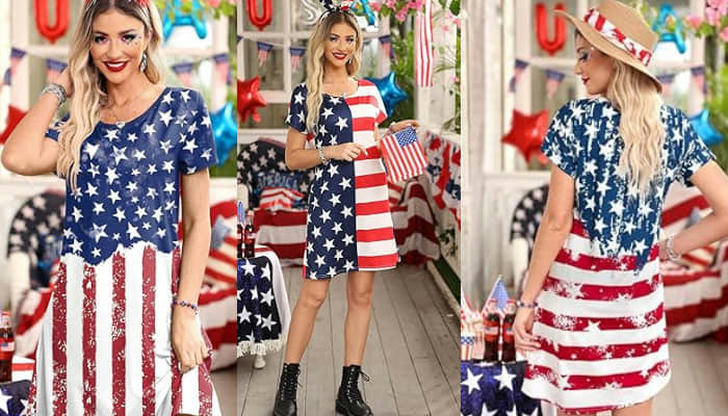The Stars and Stripes: Is it Possible to Wear the US Flag Without Irony?

In the past nine months, Casey Lewis, who keeps an eye on trends for Gen Z, noticed something interesting happening on social media. It's this old tradition of claiming new territory, but instead of physical land, people are staking their claim on social media, like on TikTok. Maybe you've seen it too.
People are showing off their American flag-themed clothing, like a Polo Ralph Lauren pullover that costs around $400 or even a fancier cashmere version for $1,490. There's also a Brandy Melville version and one from Tuckernuck for $248. Denimist sells theirs for $365, and there are cheaper options from fast-fashion brands. Lewis even spotted a popular knockoff on TikTok that goes for just $11. People are really getting into it, comparing which ones they have, and during Christmas, tons of them were unwrapping ones they got as gifts.
But here's the thing—especially with President Biden and many members of Congress expected to wear American flag pins at the State of the Union address—there's a question hanging in the air: Can regular folks wear American flag clothing without it being seen as political? Can wearing a sweater or a dress with the flag on it just mean you're celebrating Americana, without people assuming you're aligned with extreme political views?

American flag fashion used to be associated with cheesy BBQ accessories and limited-edition stuff from Old Navy. But since around 2016, it's gained a new significance. What's considered trendy nostalgia on TikTok might not get the same love in liberal areas. For a lot of progressive-minded folks, showing off patriotism visually isn't as cool as it used to be. It's like those old skinny jeans and hairstyles we've moved on from.
To writer Lauren Sherman, who runs Puck's Line Sheet newsletter, the American flag used to symbolize pride in being American, especially for working-class families like hers. But now, wearing the flag can make people think you're conservative. Even in her own family, things have changed. When she was younger, everyone would dress up in flag tees for the Fourth of July. But now, most of them wouldn't be caught dead wearing one.

Just like any fashion trend that falls out of favor, it's not the flag itself that's changed—it's what people think it represents.
In places that lean Democratic, where fashion is a big part of expressing yourself, patriotism is often associated with a certain type of politics—think isolationists and populists. Waving a flag on your porch or wearing flag-themed hats and pins might seem like something for "them," not "us." This discomfort has consequences. Brands are careful about how they incorporate preppy styles into their collections, often adding a twist or a bit of irony to avoid coming across as old-fashioned or exclusive.
Sherman is noticing the same comeback of Polo Ralph Lauren that Lewis sees on social media, but she points out that the most popular looks are actually inspired by vintage Polo. It's a more accurate homage than people might realize. Even though the brand became known as a symbol of elitism, Ralph Lauren himself grew up in the Bronx with immigrant parents. Who better to market the American flag than someone who knows a thing or two about reinvention and embracing different cultures?

It's interesting how people approach wearing the American flag compared to something like camouflage print. Camo, originally developed for the military, has become a fashion staple that doesn't carry the same political weight. Nobody wearing a big Marc Jacobs camo jacket worries about being seen as supporting aggressive foreign policies.
To navigate this uncertainty in fashion, Lewis has noticed some creators playfully acknowledge the political undertones of a new sweater by framing it as a Lana Del Rey-style statement, evoking the Americana vibes from the singer's nostalgic music videos rather than any political affiliation. But Lewis believes most Gen Z folks driving this trend don't see the sweater as making a political statement at all. "I think it's appealing to a young generation who spent a lot of their early school years wearing fast-fashion brands like Shein or H&M," she says. "There's something about an oversized American flag knit that feels classy and timeless."

Especially for a generation like Gen Z, who haven't experienced as many political ups and downs as older folks, there's a notable trend. "Most of the TikTokers showing off these sweaters are from Gen Z," Lewis notes. "I haven't come across a single millennial doing the same. Millennials have been through more—they understand that things can be complicated. I don't think Gen Z is necessarily super conservative; they just might not fully grasp the deeper meaning behind the American flag. It's more than just a trendy Brandy Melville item—it carries a lot of weight."
It's fascinating how the American flag hasn't always been associated solely with conservative ideals. In a curious twist of fate, designer Catherine Malandrino created a flag shirtdress just before 9/11 that ended up being worn by Halle Berry, Julia Roberts, Sharon Stone, and Madonna.

The dress was bold, with wide stripes and stars as big as silver dollars—it made a powerful statement. It became so iconic that Malandrino brought it back to celebrate Barack Obama's historic election in 2008. Celebrities like Kelly Ripa and Meryl Streep also wore it. Streep even wore it again at the Democratic Convention in 2016 to mark Hillary Clinton's nomination as the first woman to lead a major party's ticket. The dress symbolized a belief in the kind of nation America could be.

"That kind of dress wouldn't be accepted nowadays," Sherman remarks. "A designer promoting feminist and progressive values wouldn't even consider making it." It's likely that sincere TikTokers aren't aware that one of the most notable wearers of the Polo Ralph Lauren sweater in recent times is former GOP presidential candidate Nikki Haley, who has been seen sporting two versions.
(Meanwhile, Donald Trump has released—and quickly sold out—gilded "Never Surrender" high-tops priced at $399, featuring an American flag detail on the back. Perhaps the profits will help alleviate his growing legal debts, which currently exceed $400 million.)
Sherman notes that those who proudly display their patriotism tend to be individuals who believe the country is heading in the right direction. If you're convinced that America is on a downward spiral, you're unlikely to wrap yourself in the flag.

There's actually a rebellious way to wear the flag too. In 2019, designer Telfar Clemens made a bold statement at his Fashion Week presentation by having all attendees enter through a hole ripped in the middle of a giant American flag. Then, in 2021, Zac Posen dressed Debbie Harry in a gown made from a tattered flag for the Met Gala, with the dress's stripes wrapped around a visible cage skirt.
The label Vaquera has also showcased star-spangled dresses, like the bold, triumphant number they unveiled in 2017, designed before Donald Trump's election but shown in defiance afterward. In 2022, they featured another flag dress, this time ripped and faded but still unmistakable. It wasn't pristine or preppy like a sweater, but it certainly made a statement.

Back in the day, punks and rebels in England took hold of the Union Jack and made it a symbol of revolution. "They commandeered it," Sherman explains. "So when I think of the British flag, I still think of the Sex Pistols and Vivienne Westwood—not the Tories and Conservatives."
After November, wearing an American flag print might feel even more off-limits than it does currently. Then again, it could take on a rebellious sort of meaning. "Young people can redefine it," Sherman suggests optimistically. There's still potential for the old flag to be reimagined in new and unexpected ways.
